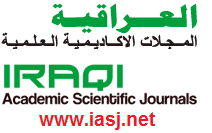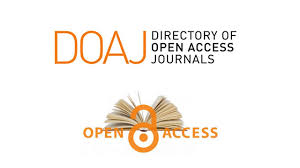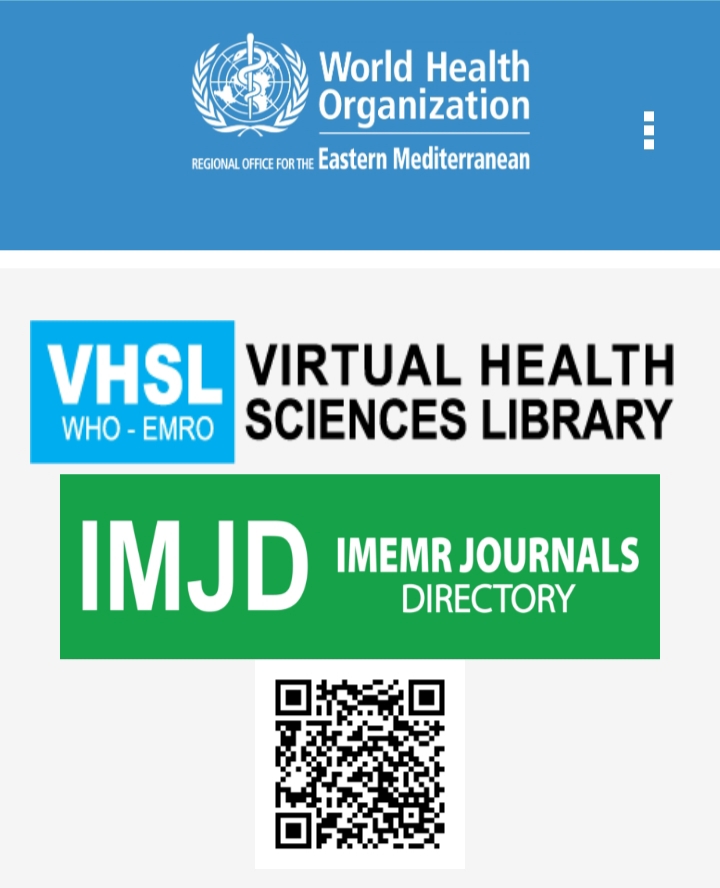Modulation Effects of Formulated Topical Nifedipine Ointment on IL- 6 and C-Reactive Protein During Facial Skin Wound Healing in Rabbits
Abstract
The current study aimed to assess the modulation effect of 1% and 2% topical nifedipine ointment on IL-6 and CRP during facial skin wound healing in rabbits. Materials and Methods: Nifedipine ointments of 1% and 2% were prepared. Fifty healthy male rabbits were included and divided equally into two groups based on the research period: group A (7 days) and group B (14 days). Each group was divided into five groups, each with five rabbits. Group I (normal), Group II (negative control), Group III (positive control), Group IV(NFD1%), and Group V (NFD 2%). All animals except group I were anesthetized. A circular, full-thickness excisional wound of 1 cm in diameter was surgically induced on each rabbit's forehead. The wounds were left open; group II did not receive any treatment. Group III, Group IV, and Group V were treated topically twice daily with white petrolatum jelly, nifedipine ointment 1%, and nifedipine ointment 2%, respectively, until the day of euthanasia. Blood samples (5 mL) were collected on the 7th and 14th days from all animals via the jugular vein during euthanasia. The serum was separated for measurement of IL-6 and CRP. Results: On the 7th day, there was a significant rise in IL-6 and CRP levels in the NFD1% and NFD2% groups compared to the other groups, but the increase will be greater in the NFD2% group. On the 14th day, there was no significant difference in IL-6 levels among the normal, negative control, and NFD1% groups, but there was a significant difference between the NFD2% group and the other groups. There was no significant difference in the CRP level between the NFD1% and NFD2% groups. Conclusions: Topical application of NFD1% ointment improves facial skin wound healing in rabbits by moderately modulating the inflammatory response and accelerating wound closure, whereas the modulating effect of NFD2% ointment delayed healing.
References
- -Lauritano, D., Moreo, G., Vella, F. D., Palmieri, A., Carinci, F., & Petruzzi, M. (2021). Biology of Drug-Induced Gingival Hyperplasia: In Vitro Study of the Effect of Nifedipine on Human Fibroblasts. Applied Sciences, 11(7), 3287.
- - Friciu, M., Chefson, A., & Leclair, G. (2016). Stability of Hydrocortisone, Nifedipine, and Nitroglycerine Compounded Preparations for the Treatment of Anorectal Conditions. The Canadian journal of hospital pharmacy, 69(4), 329.
- -Katsinelos, P., Papaziogas, B., Koutelidakis, I., Paroutoglou, G., Dimiropoulos, S., Souparis, A., & Atmatzidis, K. (2006). Topical 0.5% nifedipine vs. lateral internal sphincterotomy for the treatment of chronic anal fissure: long-term follow-up. International journal of colorectal disease, 21(2), 179-183.
- -Nazir, T., Shakir, L., Rahman, Z. U., Najam, K., Choudhary, A., Saeed, N., ... & Khanum, A. B. (2020). Hepatoprotective Activity of Foeniculum Vulgare Against Paracetamol Induced Hepatotoxicity in Rabbit. J. Appl. Pharm, 12, 2376-0354.
- -Ricci, F., Bresesti, I., LaVerde, P. A. M., Salomone, F., Casiraghi, C., Mersanne, A., ... & Lista, G. (2021). Surfactant lung delivery with LISA and InSurE in adult rabbits with respiratory distress. Pediatric research, 90(3), 576-583.2
- - Ragab, G. H., Zaki, F. M., Hassan, F. E., & Safwat, N. M. (2021). Comparable Study of Different Materials (Silver Nanoparticles, PRP and its Mixture) That Enhance Surgical Excisional Skin Wound Healing in New Zealand Rabbits; Histopathological Evaluation. Annals of the Romanian Society for Cell Biology, 25(6), 15966-15975.
- - Naji, A. H., Al-Watter, W. T., & Taqa, G. A. (2022). The Effect of Xylitol on Bone Alkaline Phosphatase Serum Level and Bone Defect Diameter in Rabbits. Journal of Applied Veterinary Sciences, 7(1), 6-10.
- -Triola, M. M., Triola, M. F., & Roy, J. A. (2006). Biostatistics for the biological and health sciences. Boston: Pearson Addison-Wesley.
- -Naghavi, M., Tamri, P., & Asl, S. S. (2021). Investigation of healing effects of cinnamic acid in a full-thickness wound model in rabbit. Jundishapur Journal of Natural Pharmaceutical Products, 16(1).
- - Brasileiro, A. C. L., Oliveira, D. C. D., Silva, P. B. D., & Rocha, J. K. S. D. L. (2020). Impact of topical nifedipine on wound healing in animal model (pig). Jornal Vascular Brasileiro, 19.
- - Zolfagharnezhad, H., Khalili, H., Mohammadi, M., Niknam, S., & Vatanara, A. (2021). Topical nifedipine for the treatment of pressure ulcer: a randomized, placebo-controlled clinical trial. American Journal of Therapeutics, 28(1), e41-e51.
- - Mojiri-Forushani, H. (2018). The role of calcium channel blockers in wound healing. Iranian journal of basic medical sciences, 21(12), 1198.
- -Kingsley, A., & Jones, V. (2008). Diagnosing wound infection: the use of C-reactive protein. Wounds Uk, 4(4), 32-46.
- - Salvo, P., Dini, V., Kirchhain, A., Janowska, A., Oranges, T., Chiricozzi, A., ... & Romanelli, M. (2017). Sensors and biosensors for C-reactive protein, temperature and pH, and their applications for monitoring wound healing: a review. Sensors, 17(12), 2952.
- - Costantini, E., Aielli, L., Serra, F., De Dominicis, L., Falasca, K., Di Giovanni, P., & Reale, M. (2022). Evaluation of Cell Migration and Cytokines Expression Changes under the Radiofrequency Electromagnetic Field on Wound Healing In Vitro Model. International Journal of Molecular Sciences, 23(4), 2205.
- - Johnson, B. Z., Stevenson, A. W., Prle, C. M., Fear, M. W., & Wood, F. M. (2020). The role of IL-6 in skin fibrosis and cutaneous wound healing. Biomedicines, 8(5), 101.
- -Bekeschus, S., von Woedtke, T., Emmert, S., & Schmidt, A. (2021). Medical gas plasma-stimulated wound healing: Evidence and mechanisms. Redox biology, 46, 102116.
- -Caley, M. P., Martins, V. L., & O'Toole, E. A. (2015). Metalloproteinases and wound healing. Advances in wound care, 4(4), 225-234.
- -Serra, F., Aielli, L., & Costantini, E. (2021). The role of miRNAs in the inflammatory phase of skin wound healing. AIMS Allergy and Immunology, 5(4), 264-278.
- -Sato, K., Takeda, A., Hasegawa, E., Jo, Y. J., Arima, M., Oshima, Y.,... & Sonoda, K. H. (2018). Interleukin-6 plays a crucial role in the development of subretinal fibrosis in a mouse model. Immunological Medicine, 41(1), 23-29.
- -Gallucci, R. M., Simeonova, P. P., Matheson, J. M., Kommineni, C., Guriel, J. L., Sugawara, T., & Luster, M. I. (2000). Impaired cutaneous wound healing in interleukin6deficient and immunosuppressed mice. The FASEB journal, 14(15), 2525-2531.
- -Ellis, S., Lin, E. J., & Tartar, D. (2018). Immunology of wound healing. Current dermatology reports, 7, 350-358.
- -Tonsekar, P., & Tonsekar, V. (2021). Calcium-Channel-Blocker-Influenced Gingival Enlargement: A Conundrum Demystified. Oral, 1(3), 236-249.
- - Hemmati, A. A., Forushani, H. M., & Asgari, H. M. (2014). Wound healing potential of topical amlodipine in full thickness wound of rabbit. Jundishapur journal of natural pharmaceutical products, 9(3).
- -Miricescu, D., Badoiu, S. C., Stanescu-Spinu, I. I., Totan, A. R., Stefani, C., & Greabu, M. (2021). Growth Factors, Reactive Oxygen Species, and MetforminPromoters of the Wound Healing Process in Burns?. International Journal of Molecular Sciences, 22(17), 9512.
- -Mojiri-Forushani, H. (2018). The role of calcium channel blockers in wound healing. Iranian journal of basic medical sciences, 21(12), 1198.
- -Agyare, C., Osafo, N., & Boakye, Y. D. (2019). Biomarkers of Wound Healing. Wound Healing-Current Perspectives.
- -Tagliari, E., Campos, L. F., Casagrande, T. A. C., Fuchs, T., de Noronha, L., & Campos, A. C. L. (2021). Effects of oral probiotics administration on the expression of transforming growth factor and the proinflammatory cytokines interleukin 6, interleukin 17, and tumor necrosis factor in skin wounds in rats. Journal of Parenteral and Enteral Nutrition.
- -Sproston, N. R., & Ashworth, J. J. (2018). Role of C-reactive protein at sites of inflammation and infection. Front Immunol. 2018; 9: 754. URL: https://www. frontiersin. org/articles/10.3389/fimmu.











